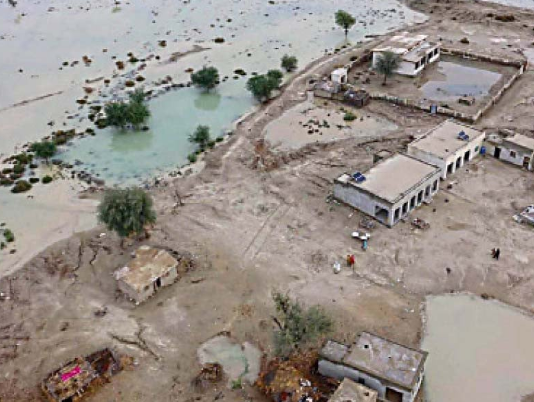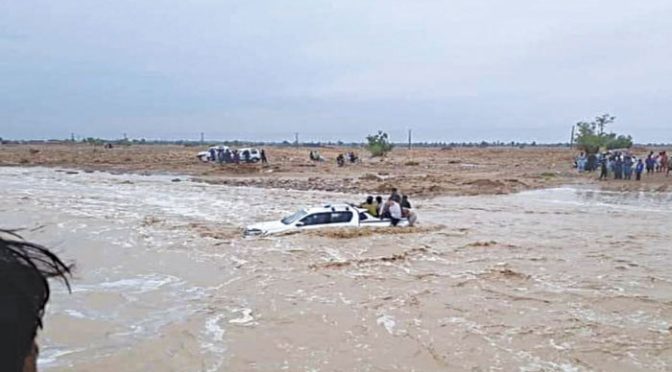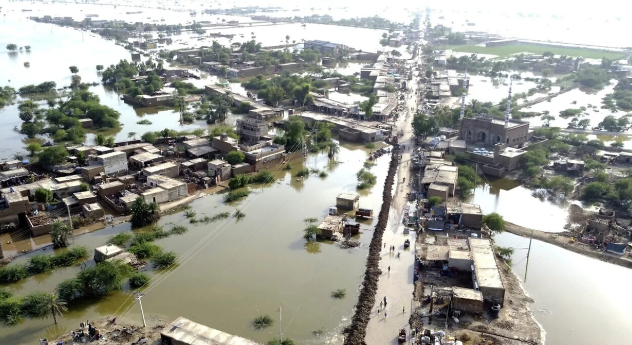In Gwadar And Other Areas Of Balochistan, Torrential Rain And Flooding Cause Havoc
Following severe rains that caused havoc in the city, the government of Balochistan declared Gwadar to be under a state of calamity and declared an emergency.
In Gwadar, Makran, and the northern and central regions of Balochistan, regular activities and traffic had been suspended for 30 hours, causing flash floods that buried most of the areas.
Gwadar had received about 180 millimeters of rain in the previous two days, according to officials.
The city received 60mm of rain in the previous 24 hours, according to a rainfall report that the Pakistan Meteorological Department (PMD) released at 8 a.m. today.
With 72 mm of rain, Jiwani saw the most, followed by Kalat with 53 mm, Khuzdar with 34 mm, Sibbi with 30 mm, Dalbandin with 21 mm, and Turbat with 20 mm.
“Really, the situation in Gwadar is a bit bad,” stated Director General Jahanzeb Khan of the Provincial Disaster Management Authority (PDMA).
Khan explained in a video statement that “187mm of rainfall during the last two days” had caused the port city to experience flooding.
He said that efforts were underway to remove the accumulated rainwater. Along with other institutions, the PDMA, Pakistan Army, Navy, and district administration were participating in the relief and rescue efforts, Khan continued.
The PDMA DG added that those whose houses had flooded were taken to safe places for evacuation. He issued a warning, saying that the province would see rain for the next two days.
Khan continued by saying that letters with instructions to handle any undesirable situation have been sent to the affected districts once more.
He also mentioned that the PDMA control room in Quetta was operational around-the-clock and that he was in continual communication with deputy commissioners throughout Balochistan.
Widespread heavy thunderstorm (heavy snowfall over hills) is expected in Nokkundi, Dalbandin, Chagi, Lasbella, Awaran, Turbat, Kech, Gwadar, Jiwani, Pasni, Ormara, Panjgur, Kharan, Washuk, Noushki, Kalat, Khuzdar, Mastung, Sibbi, Naseerabad, Kohlu, Jhal Magsi, Loralai, Zhob, Sherani, Barkhan, Musakhel, Ziarat, Quetta, Chaman, Pishin, Qila Abdullah and Qila Saifullah.
It stated, “An isolated hailstorm is also likely during the period.” In the majority of the province’s districts, “mainly dry weather” is predicted for tomorrow. “Yet, isolated locations in Quetta, Ziarat, Zhob, and Barkhan are expected to experience partly cloudy weather with rain or snowfall over hills,” the statement continued.
Disrupting Daily Activities And Traffic in Gwadar
Most of the areas were submerged by flash floods caused by the 30-hour rains. After being summoned by the local government, paramilitary forces arrived in the flood-affected areas and began rescue and relief efforts. In the areas affected by the rain, the Gwadar district administration proclaimed a state of emergency.

According to officials, the last two days saw about 180 millimeters of rain fall on the Gwadar district, disrupting daily life and leaving hundreds of people without a place to live. Numerous residential communities and business buildings collapsed due to floodwaters entering homes, and numerous roads suffered significant damage.
Due to damage to the coastal highway, traffic between Karachi and Gwadar could not be restored.
Houses were flooded, forcing families to relocate to safer areas. Gwadar resident Hayatullah Baloch told Dawn over the phone, “We lost our precious households in the floodwater and our houses were not in position to live in.”
The port city’s sewerage system became clogged when floodwater entered it, causing sewage water to spill onto the streets and roadways. Gwadar lacks a water drainage system, and the few pumps that were operational were unable to adequately drain the flooded areas. People were experiencing a shortage of drinking water as a result of the severe damage done to the water supply system. Many of the dykes in Surbandan, Jewany, Palery, and other places, as well as the Gwadar-Peshkan road, have been washed away.
About 280 people, including women and children whose homes had collapsed, had reportedly been rescued and taken to the GDA Rest Houses and China School, according to the officials. Over a hundred houses had their boundary walls washed away.
They claimed that the people affected by the floods were receiving assistance from the army, navy, Gwadar Development Authority, Gwadar Port Authority, and municipal committee.
In the meantime, rain and snowfall in Quetta and many other towns inundated the roads and human settlements. The areas of Quetta, Ziarat, Kalat, Mastung, and Pishin experienced power and gas supply disruptions due to the overnight rains.
The Government of Balochistan Declared Gwadar a “Disaster Zone”
Following severe flash floods in the coastal city of Gwadar caused by heavy rains on Thursday, the caretaker government of Balochistan declared a disaster zone and declared an emergency in the area.
The provincial government of Balochistan, in recognition of the gravity of the situation, decided to declare Gwadar a calamity and to impose an emergency, according to a statement issued by caretaker Information Jan Achakzai.
Achakzai claims that a notification will be sent out shortly and that caretaker Balochistan Chief Minister Ali Mardan Khan Domki has already signed a summary for this reason.
He went on to say that the acting chief medical officer would personally oversee relief efforts in every province region affected by flooding.
Maulana Hidayatur Rehman, the chief of Haq Do Tehreek Balochistan (HDTB), who won the election for PB-24, arrived in the coastal city on Thursday to oversee rescue efforts in the wake of the devastating flash floods that occurred in Gwadar. The flooding was caused by intense rainfall that battered the area for several hours, leaving thousands of residents homeless and in desperate need of assistance.
The residents’ suffering was exacerbated by the heavy downpours, which not only flooded residential areas but also interfered with vital services like the power supply and the already overburdened sewer system.
As the situation worsens, immediate action is being taken to give those impacted by the disaster food, shelter, and medical attention.
At a startling depth of six to seven feet, the streets of Gwadar were submerged under rainwater.
Over the past two days, the Gwadar district has received over 180 millimeters of rainfall, according to officials.
The heavy rainfall damaged the coastal highway that connected Gwadar with Karachi, causing traffic disruptions.
The effects of the flash floods have not only affected Gwadar but also Quetta and other areas of Balochistan due to the heavy rainfall.
The interim provincial information minister said in the statement that rescue and relief efforts were underway in coastal areas affected by the heavy rains.
“In Gwadar, Ormara, Pasni, and other areas, teams from the district administration, army, navy, Provincial Disaster Management Authority, Levies, and National Disaster Management Authority are working day and night,” he continued.
He went on to say that every resource at hand was being used for both the affected population’s welfare and the removal of the accumulated rainwater.
Achakzai voiced worries about the significant harm that the constant rains were causing to Gwadar’s essential infrastructure.
“The most recent information indicates that approximately 300 people have been safely relocated and that two of the six disconnected roads from Gwadar city have been restored,” he insisted.
He said that about eighty boats had been sent to the scene to help with the evacuation.
The statement said, “Assessments are being conducted in the area to determine the extent of damage.”
Separately, interim chief minister Domki announced that the army was assisting with rescue efforts in the areas affected by the rain.
He noted in a statement that the intense rains had created a “unusual and disastrous situation.”
The education department of Balochistan has prioritized the safety of students and staff by ordering the closure of all government and private schools throughout the province due to the unfavorable weather.
The devastation caused by the unceasing downpour and hailstorm that persisted in Gwadar and its environs worsened the situation for rescue personnel and the impacted populace.
In addition, the rains in Nagor have caused protective dams to burst, making the already dangerous situation worse.
In the midst of the destruction, initiatives are underway to offer support and relief to individuals dealing with the fallout from the flash floods.
The prompt and resolute actions exhibited by MPA Hidayatur Rehman and other relevant parties highlight the perseverance and empathy of the Pakistani populace during difficult times.
People Lives Are Paralyzed By Heavy Rains
In Pakistan’s Balochistan province, the coastal town of Gwadar has suffered greatly due to heavy rains. Over the course of the 15-hour downpour, entire neighborhoods were submerged, leaving streets, homes, and roads covered in water.

Under the assault, the power transmission system stumbled and life came to a complete halt.
The rain, which originated from a weather system that moved into Balochistan on February 25, pounded the area mercilessly. Chaos and widespread flooding have resulted from it.
Videos that are making the rounds on the internet show the seaside town covered in water, with cars driving through knee-deep floods.
Senator Kohda Babar described the terrible circumstances that the people were living in during the chaos, emphasizing how the old town was submerged several feet below the surface of the water.
“People don’t even have a place to sleep because water has entered the houses,” he bemoaned, highlighting the dearth of official response in situations like this.
Reports of house collapses and severe property damage surfaced as the waters rose. The suffering of the impacted population was exacerbated by the fact that thousands of fishermen lost their houses and boats to the floods.
The extent of the calamity outstripped the resources available, despite the efforts of local authorities and relief teams.
Both the National Disaster Management Authority (NDMA) and the Provincial Disaster Management Authority (PDMA) were urged to act quickly and demanded payment for any losses incurred. But the situation of the impacted citizens was made worse by the lack of a government response.
The possibility of more disaster looms large over Gwadar and its people as more unfavorable weather, including thunderstorms and snowfall in hilly areas, is predicted for the next few days.


Comments are closed, but trackbacks and pingbacks are open.